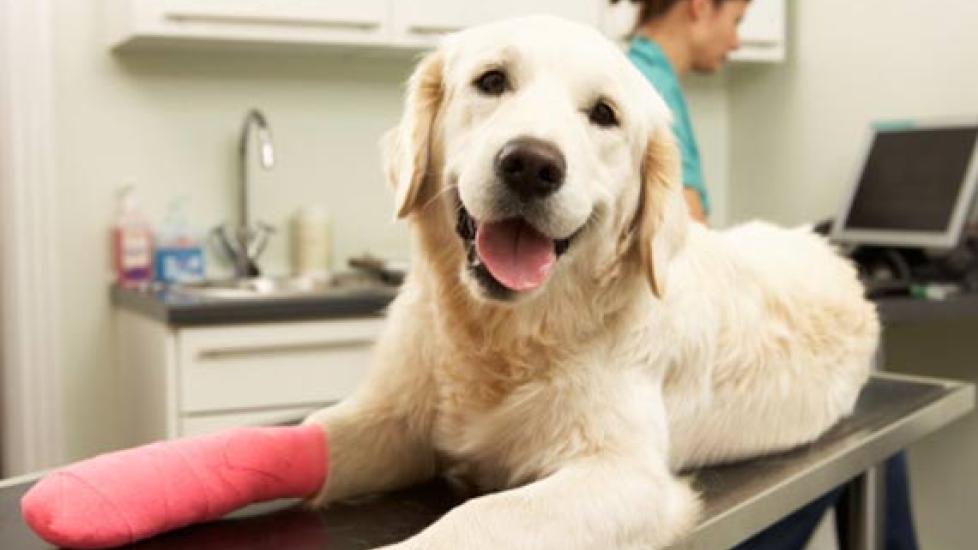What Your Vet Really Means by “The Back”
You’ve arrived for your appointment with your veterinarian and you’re nervous as to how the visit will go. Your dog started vomiting last night, and is unusually quiet at home. You know he needs to be seen by a doctor, but are worried about his anxiety level as he isn’t a huge fan of visiting the vet. His constant nervous whining and pacing in the waiting room is contributing to your already escalating stress level.
Your anxiety is eased a bit as you are greeted enthusiastically by the receptionist, who knows you and your pet by name. The recognition provides some degree of comfort, and you start to feel a bit better.
You’re brought into an exam room, where a veterinary technician asks a few basic questions on the reason for your visit. You answer as best as you can, all the while conscious of your dog’s mounting tension.
Recommended Pet Products
- Nutramax Proviable Probiotics & Prebiotics Digestive Health Supplement for Dogs & Cats, 160 count$89.98Chewy Price
- Fera Pets USDA Organic Pumpkin Plus Fiber Support for Dogs & Cats, 90 servings$34.95Chewy Price
- All Four Paws Comfy Cone E-Collar for Dogs & Cats, Black, Small$20.24Chewy Price
- Virbac Epi-Otic Advanced Ear Cleaner for Dogs & Cats, 4-fl oz bottle$12.34Chewy Price
Soon after, your veterinarian enters the room, and performs an exam and discusses your dog’s signs. They recommend several blood tests and radiographs (x-rays) to help determine the cause of your pet’s signs.
Just as you’re starting to relax, the doctor confidently states they are going to take your dog to the back, and you can go back to the waiting room while the tests are run.
You immediately relapse into a tense and agitated state.
“What exactly does my vet mean by ‘the back’?”
Nearly every owner has heard the phrase “the back” mentioned at some point during their pet’s healthcare, but few understand what actually transpires in that particular geographical region of the hospital. Experience tells me owners perceive “the back” as a remarkably mysterious and feared area of the veterinary hospital.
Have you ever asked, “why does my veterinarian need to take my pet ‘to the back?’” Do you wonder what going to “the back” even means? Is “the back” a mythical place where medicinal wonders are performed, or a torture chamber of laboratory experimentation?
I can appreciate how stressful if can be to have your pet taken away for exams, blood draws, or treatments. It’s normal to wonder what goes on ‘behind the scenes’ and why you can’t be with your pet during these procedures.
I’m here to assure you that “the back” is not a scary place at all. And to help you understand why veterinarians recommend moving your pet to a different area in order to accomplish these aforementioned tasks.
Typically, “the back” simply refers to a portion of the hospital designed for treatments and procedures. As an example, “the back” of my hospital consists of a large room with multiple exam tables and several additional pieces of equipment, which makes it superior to the smaller exam rooms for performing routine tasks.
This area also has a series of computers I use to input physical exam findings and lab work results at the same time I’m performing these tests. This helps save time and contributes to increased efficiency and productivity on my part.
The back tends to be a place to find additional staff members available to hold onto a leash or run a sample or fill out a form. For me, simply having someone who helps to ensure Fido isn’t going to up and walk away from me during an exam helps smooth an appointment over. (Veterinarian confession #1: most pet owners are really bad at restraining their animals at the vet’s office.)
The back is often a bustling location in a vet hospital, but when necessary, can also be transformed into one of the quietest areas. It’s an excellent place to listen for heart murmurs or abnormal breath sounds without worrying whether an owner will try to talk or ask questions during the procedure. (Veterinarian confession #2: when I’m wearing a stethoscope, I can’t hear anything you’re saying because those tiny ear pieces block out all external noises!)
Some pets are actually calmer when they are away from their owners, which makes it easier to perform exams or draw blood or administer a treatment. This allows the veterinarian to accomplish tasks more efficiently and safely, reducing stress for the pets.
With respect to the specifics of veterinary oncology, some doctors allow owners to be present during chemo treatments, even going as far as to permit them to restrain their pets for treatment. Our current hospital policy dictates that owners are not permitted to be present during chemotherapy treatments to reduce the risk of inadvertent exposure to drugs. However, I’m opening myself up to the idea of allowing owners to observe treatments so they are able to see firsthand how easy the process is for their pets.
You should be assured that your pet is getting excellent care when he or she is out of your sight. If you would prefer exams to be performed in your presence, you should ask your veterinarian if this is possible. If you are curious as to where exams and treatments are performed, ask the staff if it would be possible to show you around. Following these simple suggestions means you will never have to worry about what’s happening in “the back” anymore!
Dr. Joanne Intile




